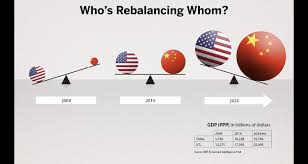Throughout the 2010s, under the current leadership of Chinese President Xi Jinping, China has successfully worked to fundamentally alter the balance of power in Asia and beyond at the expense of the United States. The country has significantly increased its military strength, applied economic coercion on countries that challenged Beijing’s objectives, and sought to undermine American vital national interests. Today, China is coupling its power and will to upend regional order in Asia and international order more broadly.
The Ascendancy of China in the 21st Century
Military Expansion
China’s military growth is one of the most pressing challenges. Over the past decade, China has invested heavily in modernizing its military capabilities, including advancements in missile technology, naval power, and cyber warfare. This expansion is seen as a direct challenge to U.S. military presence in the region.
Economic Coercion
China leverages its economic might to exert influence over other countries. This is done through trade agreements, investment in infrastructure projects like the Belt and Road Initiative (BRI), and leveraging debt diplomacy to secure political and economic concessions.
Strategic Influence
China’s strategic influence extends beyond its borders. Beijing seeks to reshape international norms and institutions to reflect its own interests. This involves active participation in global organizations and forming alliances that challenge the traditional U.S.-led international order.
Impact on Regional Order
Territorial Disputes
China’s assertive stance in territorial disputes, particularly in the South China Sea, poses a significant challenge. By building artificial islands and militarizing them, China aims to control vital maritime routes and resources, challenging the territorial claims of several neighboring countries and the principle of freedom of navigation upheld by the U.S.
Political Influence
China’s growing political influence in Asia undermines U.S. alliances and partnerships. Through economic incentives and political pressure, Beijing attempts to sway countries to align with its strategic objectives, thereby weakening U.S. influence.
Technological Dominance
China’s advancements in technology, particularly in 5G and artificial intelligence, are not just economic but also strategic. The dominance in these fields allows China to set global standards and norms, potentially compromising the security and competitiveness of the U.S. and its allies.
Why the U.S. Needs a Vigorous Asia-Centric Strategy
Rebalancing Power
To counter China’s rise, the U.S. needs to rebalance power in Asia. This involves strengthening military alliances, increasing defense capabilities in the region, and ensuring a sustained U.S. presence to deter aggression and reassure allies.
Economic Partnerships
The U.S. should foster stronger economic partnerships in Asia. Engaging in comprehensive trade agreements, investing in regional infrastructure, and promoting economic integration will help counter China’s economic influence.
Promoting Democratic Values
Promoting democratic values and human rights should be a cornerstone of the U.S. strategy. By supporting democratic institutions and practices, the U.S. can counter China’s authoritarian model and foster more stable and reliable partners in the region.
Strategic Military Measures
Enhanced Defense Cooperation
Strengthening defense cooperation with allies like Japan, South Korea, Australia, and India is crucial. Joint military exercises, intelligence sharing, and advanced weaponry deployment can enhance collective security.
Maritime Security Initiatives
The U.S. must prioritize maritime security initiatives to ensure freedom of navigation in the Indo-Pacific. This involves patrolling contested waters and supporting regional navies to enhance their maritime capabilities.
Cybersecurity Collaboration
Collaborating on cybersecurity is essential to counter China’s growing cyber capabilities. Joint efforts in cyber defense, information sharing, and establishing norms for cyber behavior can mitigate threats.
Economic and Trade Policies
Resilient Supply Chains
Building resilient supply chains that reduce dependence on China is vital. The U.S. should work with allies to diversify supply sources and develop regional alternatives.
Fair Trade Practices
Enforcing fair trade practices and addressing issues like intellectual property theft and market access is necessary. The U.S. should hold China accountable for unfair trade practices through multilateral institutions and agreements.
Technology Collaboration
Collaborating on technology with allies can counter China’s technological advancements. Joint research and development initiatives and setting global standards can ensure a competitive edge.
Diplomatic Engagement
Multilateral Alliances
Strengthening multilateral alliances and partnerships is crucial. Engaging in regional forums like ASEAN and the Quad can enhance collective responses to shared challenges.
Human Rights Advocacy
Advocating for human rights and democratic governance should be a priority. Supporting civil society and democratic movements in Asia can counter authoritarian influences.
Conflict Resolution
Promoting peaceful resolution of conflicts, particularly in the South China Sea, is essential. Diplomatic efforts to mediate disputes and uphold international law can mitigate tensions.
Promoting Regional Stability
Humanitarian Aid and Development
Providing humanitarian aid and supporting development projects can enhance U.S. influence. Assisting in disaster relief and economic development fosters goodwill and stability.
Cultural and Educational Exchanges
Cultural and educational exchanges can strengthen people-to-people ties. Promoting American culture and values through scholarships and cultural programs fosters mutual understanding.
Environmental Cooperation
Collaborating on environmental issues, such as climate change and sustainable development, can address shared challenges. Joint efforts in conservation and renewable energy promote regional stability.
China’s rise presents significant challenges that necessitate a vigorous Asia-centric strategy by the U.S. By enhancing military capabilities, fostering economic partnerships, promoting democratic values, and engaging in multilateral diplomacy, the U.S. can effectively counter China’s influence and ensure regional stability and prosperity. The future of the Indo-Pacific region depends on a balanced and cooperative approach that prioritizes mutual benefit and respects international norms.




